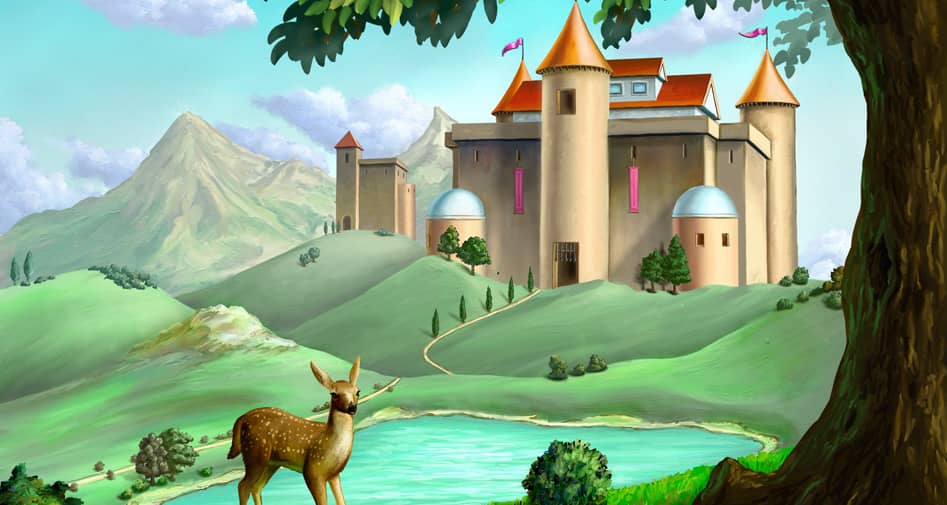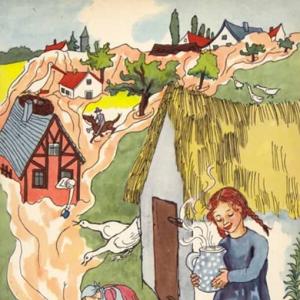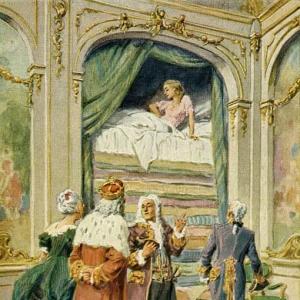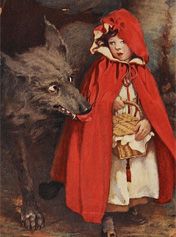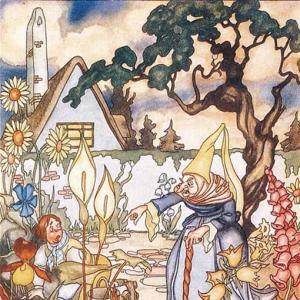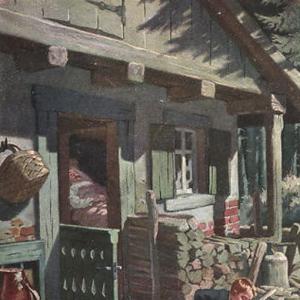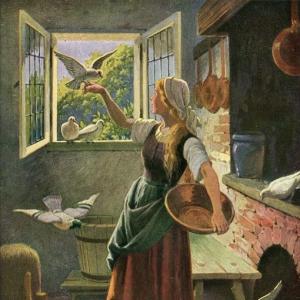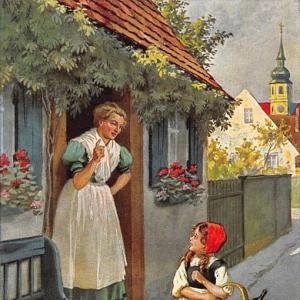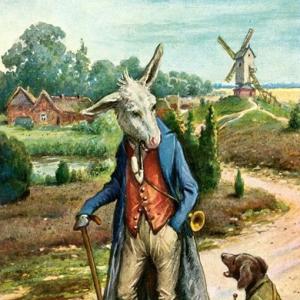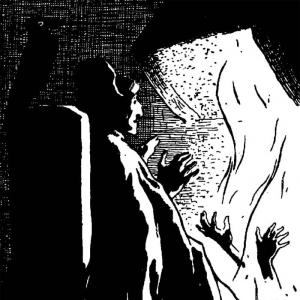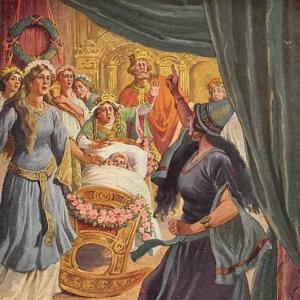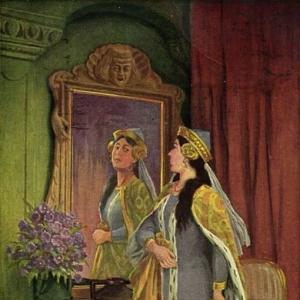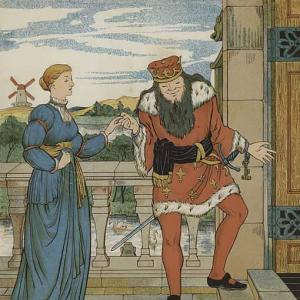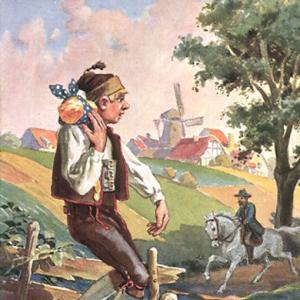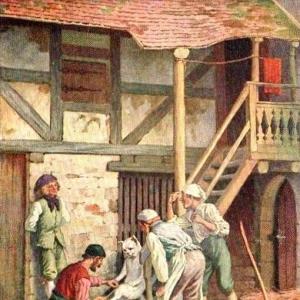Reading time for children: 6 min
When Adam and Eve were driven out of Paradise, they were compelled to build a house for themselves on unfruitful ground, and eat their bread in the sweat of their brow. Adam dug up the land, and Eve span. Every year Eve brought a child into the world; but the children were unlike each other, some pretty, and some ugly. After a considerable time had gone by, God sent an angel to them, to announce that he was coming to inspect their household. Eve, delighted that the Lord should be so gracious, cleaned her house diligently, decked it with flowers, and strewed reeds on the floor. Then she brought in her children, but only the beautiful ones. She washed and bathed them, combed their hair, put clean raiment on them, and cautioned them to conduct themselves decorously and modestly in the presence of the Lord. They were to bow down before him civilly, hold out their hands, and to answer his questions modestly and sensibly. The ugly children were, however, not to let themselves be seen. One hid himself beneath the hay, another under the roof, a third in the straw, the fourth in the stove, the fifth in the cellar, the sixth under a tub, the seventh beneath the wine-cask, the eighth under an old fur cloak, the ninth and tenth beneath the cloth out of which she always made their clothes, and the eleventh and twelfth under the leather out of which she cut their shoes. She had scarcely got ready, before there was a knock at the house-door. Adam looked through a chink, and saw that it was the Lord. Adam opened the door respectfully, and the Heavenly Father entered. There, in a row, stood the pretty children, and bowed before him, held out their hands, and knelt down. The Lord, however, began to bless them, laid his hands on the first, and said, „Thou shalt be a powerful king;“ and to the second, „Thou a prince,“ to the third, „Thou a count,“ to the fourth, „Thou a knight,“ to the fifth, „Thou a nobleman,“ to the sixth, „Thou a burgher,“ to the seventh, „Thou a merchant,“ to the eighth, „Thou a learned man.“ He bestowed upon them also all his richest blessings. When Eve saw that the Lord was so mild and gracious, she thought, „I will bring hither my ill-favoured children also, it may be that he will bestow his blessing on them likewise.“ So she ran and brought them out of the hay, the straw, the stove, and wherever else she had concealed them. Then came the whole coarse, dirty, shabby, sooty band. The Lord smiled, looked at them all, and said, „I will bless these also.“ He laid his hands on the first, and said to him, „Thou shalt be a peasant,“ to the second, „Thou a fisherman,“ to the third, „Thou a smith,“ to the fourth, „Thou a tanner,“ to the fifth, „Thou a weaver,“ to the sixth, Thou a shoemaker,“ to the seventh, „Thou a tailor,“ to the eighth, „Thou a potter,“ to the ninth, „Thou a waggoner,“ to the tenth, „Thou a sailor,“ to the eleventh, „Thou an errand-boy,“ to the twelfth, „Thou a scullion all the days of thy life.“
When Eve had heard all this she said, „Lord, how unequally thou dividest thy gifts! After all they are all of them my children, whom I have brought into the world, thy favours should be given to all alike.“ But God answered, „Eve, thou dost not understand. It is right and necessary that the entire world should be supplied from thy children. If they were all princes and lords, who would grow corn, thresh it, grind and bake it? Who would be blacksmiths, weavers, carpenters, masons, labourers, tailors and seamstresses? Each shall have his own place, so that one shall support the other, and all shall be fed like the limbs of one body.“ Then Eve answered, „Ah, Lord, forgive me, I was too quick in speaking to thee. Have thy divine will with my children.“
 Learn languages. Double-tap on a word.Learn languages in context with Childstories.org and Deepl.com.
Learn languages. Double-tap on a word.Learn languages in context with Childstories.org and Deepl.com.Backgrounds
Interpretations
Adaptions
Summary
Linguistics
„Eve’s Various Children,“ also known as „Eve’s Unequal Children,“ is a lesser-known fairy tale collected by the Brothers Grimm and numbered KHM 147 in their collection „Kinder- und Hausmärchen“ (Children’s and Household Tales). Like other tales in their collection, this story has its origins in European folklore and oral storytelling traditions.
The story of „Eve’s Various Children“ involves a conversation between Eve, the biblical first woman, and God. One day, God comes to visit Eve and asks to see her children. Eve presents only her beautiful and well-groomed children to God, hiding her less attractive and ungainly children out of shame.
God, being omniscient, is aware of the hidden children and asks Eve if she has more children. When Eve denies it, God declares that the hidden children will remain hidden from her as well, as a punishment for her dishonesty. These hidden children become the various supernatural creatures of the world, such as elves, goblins, and fairies, who remain unseen by humans. The beautiful children that Eve presented to God go on to populate the Earth as human beings.
This story offers a unique origin tale for the supernatural creatures often found in folklore and mythology. It emphasizes the importance of honesty and the consequences of deception, even in the face of shame or embarrassment. Although it is not as well-known as other Grimm fairy tales, „Eve’s Various Children“ provides an interesting explanation for the existence of supernatural beings and the importance of honesty in one’s relationship with the divine.
„Eve’s Various Children,“ also known as „Eve’s Unequal Children,“ is a lesser-known Brothers Grimm fairy tale that presents an origin story for supernatural creatures and a moral lesson about honesty. Here are some interpretations of the story.
Origin of supernatural beings:
The tale provides a unique explanation for the existence of supernatural creatures like elves, goblins, and fairies. By connecting their origins to Eve and her hidden children, the story links folklore and mythology to biblical tradition. This blending of religious and folkloric elements was a common aspect of European storytelling in the past.
Honesty and consequences of deception:
The central theme of „Eve’s Various Children“ is the importance of honesty and the consequences of dishonesty. When Eve tries to deceive God by hiding her less attractive children, she faces a punishment: her hidden children become supernatural beings who remain unseen by humans. This lesson demonstrates the significance of being truthful, even in situations where it may be uncomfortable or difficult.
Acceptance and love for all children:
Another interpretation of the story is the importance of accepting and loving all children, regardless of their appearance or abilities. By hiding her less attractive children, Eve shows a lack of love and acceptance for them. The story suggests that all children, regardless of their differences, deserve love and care, and that discrimination can lead to negative consequences.
Connection to other cultural traditions:
„Eve’s Various Children“ can also be seen as an example of the cross-cultural connections between different storytelling traditions. By incorporating biblical characters and themes alongside elements of European folklore, the story highlights the ways in which different cultural narratives can intertwine and influence one another.
In conclusion, „Eve’s Various Children“ offers a unique origin story for supernatural beings while also conveying moral lessons about honesty and acceptance. The tale demonstrates the blending of religious and folkloric elements, reflecting the rich and complex history of European storytelling traditions.
The fairy tale „Eve’s Various Children“ or „The Twelve Brothers“ by the Brothers Grimm has inspired many adaptations over the years. Here are a few examples.
„The Wild Swans“ by Hans Christian Andersen: This fairy tale by Andersen has many similarities to „Eve’s Various Children,“ including the themes of sibling loyalty and transformation through nature. In „The Wild Swans,“ a young princess must save her brothers, who have been turned into swans by an evil sorceress.
„The 12 Brothers“ (2014): This German film adaptation of the fairy tale updates the story to a modern setting, where the 12 brothers are football players who must overcome personal and professional challenges to save their team.
„Brothers Grimm“ (2005): This fantasy film directed by Terry Gilliam includes a segment based on „Eve’s Various Children,“ where the brothers are transformed into ravens instead of living as wild men.
„The Twelve Dancing Princesses“ by the Brothers Grimm: This fairy tale has many similarities to „Eve’s Various Children,“ including the themes of sibling loyalty and a group of siblings facing challenges together. In „The Twelve Dancing Princesses,“ twelve princesses must solve a mystery involving their nightly disappearances.
„The 12 Brothers“ (2007): This German animated film adaptation of the fairy tale features a group of brothers who must use their individual strengths to save their kingdom from an evil sorcerer.
These are just a few examples of the many adaptations of „Eve’s Various Children“ or „The Twelve Brothers“ that have been created over the years. The enduring popularity of this classic fairy tale is a testament to its timeless themes and engaging characters.
„Eve’s Various Children,“ also known as „Eve’s Unequal Children,“ is a lesser-known fairy tale by the Brothers Grimm that presents an origin story for supernatural creatures and a moral lesson about honesty.
The story begins with God visiting Eve and asking to see all her children. Eve, however, only presents her beautiful and well-groomed children, hiding her less attractive and ungainly children out of shame. God, being all-knowing, is aware of the hidden children and asks Eve if she has any more children. When Eve denies this, God declares that since she chose to hide them, they will remain hidden from her and other humans as punishment for her dishonesty.
As a result, the hidden children become various supernatural creatures, such as elves, goblins, and fairies, who remain unseen by humans. The beautiful children that Eve presented to God go on to populate the Earth as human beings.
The tale serves as an origin story for supernatural beings found in folklore and mythology, and it highlights the importance of honesty and the consequences of deception.
The fairy tale „Eve’s Various Children“ by the Brothers Grimm reveals a lot about the underlying social structure and values of the time through its linguistic and narrative elements. Let’s delve into a linguistic analysis of the tale, taking into account its themes, character development, and broader societal implications:
Themes
Diversity and Inequality: The tale explores the theme of diversity among Eve’s children, representing different classes and professions within society. Linguistically, this is conveyed through the specific titles and roles given to each child, reflecting a hierarchy from „king“ to „scullion. “
Divine Justice and Order: The narrative structure suggests a divine order, where God assigns roles to each child based on their appearance and the circumstances of their presentation. This reflects a belief in a cosmic or divine justice that legitimizes the social order.
Acceptance and Roles: There’s a strong message about understanding and accepting one’s role in society. Eve’s change of heart and acceptance of God’s decisions indicate a moral lesson about the necessity of various roles in maintaining societal balance.
Characterization
Eve: Linguistically, Eve is depicted as a nurturing yet initially judgmental figure. The active verbs associated with her—cleaning, washing, hiding—highlight her desire to control how her children are perceived. Her direct speech, questioning God’s decisions, portrays her as a character concerned with fairness and equality, a common human sentiment.
Children: The contrast between „pretty“ and „ugly“ children, highlighted by descriptive adjectives, emphasizes external appearances‘ significance in traditional narratives. However, each child receives a role, illustrating the tale’s moral that all are important despite physical appearances.
God: The language used for God is authoritative yet gentle, with direct speech that conveys wisdom and a grander understanding of the world’s needs. The blessings, delivered in a rhythmic and formulaic manner, reinforce His role as an omnipotent and fair deity distributing roles according to a divine plan.
Societal Implications
Class Structure: The fairy tale reflects the class-consciousness of the 19th century. The linguistic distinction between the titles „king,“ „prince,“ „merchant,“ versus „smith,“ „scullion,“ etc. , illustrates a rigid social hierarchy based on occupation and status.
Value of Labor: By blessing both groups of children, the tale underscores the value of both noble and common labor. There’s an implicit recognition that society requires a myriad of roles for balance, reminiscent of the medieval notion of a “Great Chain of Being” where every role, high or low, is essential for societal function.
Linguistic Choices: The Brothers Grimm use a formal and rhythmic style that lends a timeless, universal quality to the parable-like story. The repetition of phrases like „Thou shalt be“ gives the story a ritualistic tone, emphasizing the formality and importance of God’s proclamations.
In summary, „Eve’s Various Children“ uses language and narrative structure to reflect and reinforce contemporary societal norms and beliefs about social roles and divine justice. It’s a story that, while seemingly simple, is rich in thematic content and social commentary, revealing the values and hierarchies of its time.
Information for scientific analysis
Fairy tale statistics | Value |
|---|---|
| Number | KHM 180 |
| Aarne-Thompson-Uther-Index | ATU Typ 758 |
| Translations | DE, EN, DA, ES, PT, IT, JA, NL, PL, RU, TR, VI, ZH |
| Readability Index by Björnsson | 37.1 |
| Flesch-Reading-Ease Index | 75.3 |
| Flesch–Kincaid Grade-Level | 8.4 |
| Gunning Fog Index | 11.1 |
| Coleman–Liau Index | 8.9 |
| SMOG Index | 9.5 |
| Automated Readability Index | 9.6 |
| Character Count | 3.732 |
| Letter Count | 2.852 |
| Sentence Count | 30 |
| Word Count | 681 |
| Average Words per Sentence | 22,70 |
| Words with more than 6 letters | 98 |
| Percentage of long words | 14.4% |
| Number of Syllables | 873 |
| Average Syllables per Word | 1,28 |
| Words with three Syllables | 36 |
| Percentage Words with three Syllables | 5.3% |
